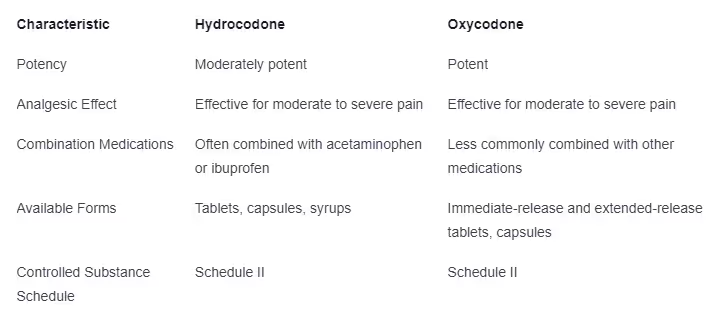Hydrocodone Vs Oxycodone: Similarities & Differences

Understanding Hydrocodone and Oxycodone
In the realm of pain management, two commonly prescribed medications are hydrocodone and oxycodone. While both drugs are opioids, they have distinct characteristics that set them apart. In this section, we will delve into what hydrocodone and oxycodone are, as well as explore their similarities and differences.
What are Hydrocodone and Oxycodone?
- Hydrocodone: Hydrocodone is a semi-synthetic opioid derived from codeine and thebaine. It is primarily prescribed to relieve moderate to severe pain. Hydrocodone is often combined with acetaminophen or ibuprofen in medications to enhance its analgesic effects. It is available in various formulations, including tablets, capsules, and syrups.
- Oxycodone: Oxycodone, also a semi-synthetic opioid, is derived from thebaine. It is used to manage moderate to severe pain. Oxycodone is available in immediate-release and extended-release formulations. The extended-release form is designed to provide pain relief for a longer duration, reducing the need for frequent dosing.
Similarities and Differences between Hydrocodone and Oxycodone
While hydrocodone and oxycodone share similarities in their classification as opioids and their medical use for pain management, there are notable differences between the two.

It's important to note that the potency of oxycodone is generally higher than that of hydrocodone. However, individual responses to these medications may vary, and the choice between hydrocodone and oxycodone should be based on a thorough evaluation by a healthcare professional.
Understanding the similarities and differences between hydrocodone and oxycodone provides a foundation for making informed decisions regarding pain management.
Medical Uses and Effects
Understanding the medical uses and effects of hydrocodone and oxycodone is essential to grasp the similarities and differences between these two medications.
Medical Uses of Hydrocodone
Hydrocodone is a potent opioid medication primarily prescribed for the management of moderate to severe pain. It is commonly used to alleviate pain following surgeries, dental procedures, and injuries. Hydrocodone is often combined with acetaminophen, which enhances its analgesic effects. This combination medication is frequently prescribed under various brand names.
Medical Uses of Oxycodone
Similar to hydrocodone, oxycodone is an opioid analgesic used for the treatment of moderate to severe pain. It is prescribed for various conditions, including postoperative pain, chronic pain, and cancer-related pain. Oxycodone may be available in immediate-release or extended-release formulations, providing different durations of pain relief.
Effects of Hydrocodone
Hydrocodone works by binding to opioid receptors in the brain and spinal cord, altering how pain signals are perceived. In addition to its pain-relieving properties, hydrocodone can induce a sense of euphoria and relaxation. It is essential to use hydrocodone only as prescribed by a healthcare professional, as misuse or abuse can lead to addiction and other serious health consequences.
Effects of Oxycodone
Oxycodone also acts on the opioid receptors in the central nervous system, providing pain relief. It produces similar effects to hydrocodone, including pain reduction and feelings of euphoria. As with hydrocodone, the recreational use or misuse of oxycodone can lead to addiction and other adverse effects.
To better understand the similarities and differences between hydrocodone and oxycodone, it is important to examine their mechanisms of action, side effects, and legal status. By exploring these aspects, individuals can make informed decisions regarding the use of these medications.
Mechanism of Action
To understand the differences between hydrocodone and oxycodone, it is essential to delve into their respective mechanisms of action. The way these medications work in the body can shed light on their similarities and differences.
How Hydrocodone Works
Hydrocodone is a semi-synthetic opioid analgesic that works by binding to opioid receptors in the brain and spinal cord. It primarily targets the mu-opioid receptors, which are responsible for pain relief. By binding to these receptors, hydrocodone helps to reduce the perception of pain and provides a sense of relief.
In addition to its analgesic effects, hydrocodone also acts on other opioid receptors, such as kappa and delta receptors. These interactions can contribute to additional effects, such as sedation and respiratory depression.
How Oxycodone Works
Similar to hydrocodone, oxycodone is also a semi-synthetic opioid analgesic. It works by binding to mu-opioid receptors in the brain and spinal cord, thereby altering the perception of pain. By activating these receptors, oxycodone helps to alleviate pain symptoms.
Oxycodone's mechanism of action is similar to that of hydrocodone, as both medications primarily target the mu-opioid receptors. However, oxycodone may have a more potent analgesic effect compared to hydrocodone.
It is important to note that both hydrocodone and oxycodone carry the risk of tolerance, dependence, and addiction. These medications should only be used under the supervision of a healthcare professional and as prescribed.
Understanding the mechanism of action can help healthcare providers make informed decisions when prescribing hydrocodone or oxycodone for pain relief.
Please note that the information provided here is for educational purposes only and should not substitute professional medical advice.
Side Effects and Risks
Both hydrocodone and oxycodone, being potent opioid medications, can have side effects and carry certain risks. It's important to be aware of these potential effects before taking these medications. Let's explore the common side effects and specific risks associated with both hydrocodone and oxycodone.
Common Side Effects of Hydrocodone
Hydrocodone can cause several common side effects, which may vary in intensity from person to person. These side effects may include:
- Nausea and vomiting
- Constipation
- Drowsiness
- Dizziness
- Headache
- Dry mouth
- Itching
- Sweating
It's important to note that not everyone experiences these side effects, and they may subside as the body adjusts to the medication. If any of these side effects persist or worsen, it's crucial to consult a healthcare professional.
Common Side Effects of Oxycodone
Similar to hydrocodone, oxycodone can also produce common side effects, although the specific intensity and occurrence may vary among individuals. Common side effects of oxycodone may include:
- Nausea and vomiting
- Constipation
- Drowsiness
- Dizziness
- Headache
- Dry mouth
- Sweating
- Itching
Again, not everyone may experience these side effects, and they may diminish over time. If these side effects persist or become bothersome, seek medical advice.
Risks and Precautions of Hydrocodone
Hydrocodone, like other opioids, carries specific risks and precautions that need to be considered. Some important points to keep in mind include:
- Potential for addiction and dependence: Hydrocodone has a high potential for addiction and dependence, particularly when misused or taken for extended periods. It's essential to follow the prescribed dosage and duration recommended by a healthcare professional.
- Respiratory depression: Hydrocodone can slow down breathing, especially when taken in high doses or combined with other substances that have a sedating effect, such as alcohol. Individuals with respiratory conditions should exercise caution and consult their healthcare provider.
- Drug interactions: Hydrocodone may interact with other medications, including certain antidepressants, sedatives, or antihistamines. It's crucial to inform your healthcare provider about all medications you are taking to avoid potential interactions.
Risks and Precautions of Oxycodone
Oxycodone also comes with specific risks and precautions that should be taken into account. Some important considerations include:
- Addiction and dependence potential: Oxycodone, like hydrocodone, has a high potential for addiction and dependence. Strict adherence to the prescribed dosage and duration is crucial to minimize these risks.
- Respiratory depression: As with hydrocodone, oxycodone can cause respiratory depression, especially when misused or combined with other substances that depress the central nervous system. Individuals with respiratory conditions should consult their healthcare provider before taking oxycodone.
- Drug interactions: Oxycodone can interact with various medications, including sedatives, muscle relaxants, and certain antibiotics. It's important to inform your healthcare provider about all medications you are taking to avoid potential interactions.
Understanding the common side effects and risks associated with both hydrocodone and oxycodone is essential for making informed decisions about pain management. Always consult a healthcare professional for personalized advice regarding these medications and their potential effects on your health.
Legal Status and Regulations
Understanding the legal status and regulations surrounding hydrocodone and oxycodone is important for both medical professionals and individuals who may be prescribed these medications. Let's take a closer look at the legal status of both hydrocodone and oxycodone.
Legal Status of Hydrocodone
Hydrocodone is classified as a Schedule II controlled substance in the United States. This classification means that hydrocodone has a high potential for abuse, may lead to severe psychological or physical dependence, and is only available with a prescription from a licensed healthcare provider. Schedule II substances are tightly regulated due to their potential for misuse and addiction.
In 2014, the U.S. Drug Enforcement Administration (DEA) rescheduled hydrocodone combination products, such as those containing hydrocodone and acetaminophen, from Schedule III to Schedule II. This change was made to further control the availability and use of hydrocodone due to the increasing concerns about its abuse and addiction potential.
Legal Status of Oxycodone
Similar to hydrocodone, oxycodone is also classified as a Schedule II controlled substance in the United States. It is recognized as a potent opioid analgesic and carries a high risk for abuse and addiction. Oxycodone is available only with a prescription from a licensed healthcare provider due to its potential for misuse and dependence.
Oxycodone is commonly prescribed for the management of moderate to severe pain when other treatment options have not provided adequate relief. However, its Schedule II classification ensures that its distribution and use are closely monitored and regulated.
It's important to note that the legal status and regulations surrounding hydrocodone and oxycodone may vary in different countries. If you have any questions or concerns regarding the legal aspects of these medications in your specific region, it is recommended to consult with a healthcare professional or refer to local regulations.
Understanding Hydrocodone and Oxycodone
To fully comprehend the similarities and differences between hydrocodone and oxycodone, it's essential to have a clear understanding of these two medications.
What are Hydrocodone and Oxycodone?
Hydrocodone and oxycodone are both opioid medications commonly prescribed for the management of moderate to severe pain. They belong to a class of drugs known as narcotic analgesics, which work by binding to specific receptors in the brain to reduce pain sensations.
While hydrocodone and oxycodone share similarities in their mechanism of action and medical uses, there are important distinctions to consider when comparing these medications.
Similarities and Differences between Hydrocodone and Oxycodone

It's important to note that the specific effects and experiences of individuals may vary, and the choice between hydrocodone and oxycodone should be made in consultation with a healthcare professional.
In the subsequent sections, we will delve into the medical uses, effects, mechanism of action, side effects, risks, and legal status of hydrocodone and oxycodone to provide a comprehensive understanding of these medications.
Conclusion
After exploring the similarities and differences between hydrocodone and oxycodone, it is clear that both medications share a mechanism of action and carry similar risks and side effects. While they are often used interchangeably for pain management, there are important distinctions between these medications that should be considered when making treatment decisions.
It is essential to consult with a healthcare professional before taking any medication, including hydrocodone or oxycodone. Misuse or overuse of these opioids can lead to addiction, dependence, and other adverse effects.
By understanding the medical uses, mechanisms of action, side effects, risks, and legal status of these medications, individuals can make informed decisions about their health. It's crucial to follow prescribed dosages and durations while under medical supervision to minimize the risk of complications.
In conclusion, while hydrocodone and oxycodone may appear similar on the surface, they have critical differences that should be carefully considered when determining which medication is most appropriate for managing pain.
